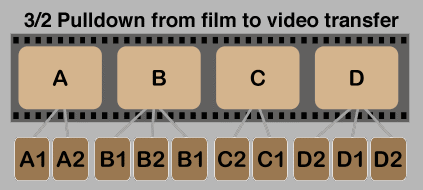|
The process differs for PAL and NTSC video. Movies on film are shot at a frame rate of 24 fps (frames per second) while NTSC video has a frame rate of 30 fps (actually 29.97) and PAL/SECAM video has a frame rate of 25 fps. These frame rates are too low for a flicker free result when viewing on a TV screen or movie screen. Each frame on film is projected twice giving a displayed frame rate of 48 fps. Unlike film video frames each comprise two interlaced fields, so that the field rate is 60 and 50 per second respectively for NTSC and PAL/SECAM. These are high enough for a flicker free moving image. The use of interlaced fields reduces flicker without reducing resolution. When converting film to video it is necessary to convert the frame rate. Film to PAL conversion usually involves speeding up the film from 24 fps to 25 fps and using a pitch correction for the audio. Converting film to NTSC video uses a 3/2 pulldown (ie alternately converting frames to 2 and 3 fields) where a group of 4 frames are converted to 5 frames or, actually, 10 fields as below:

|